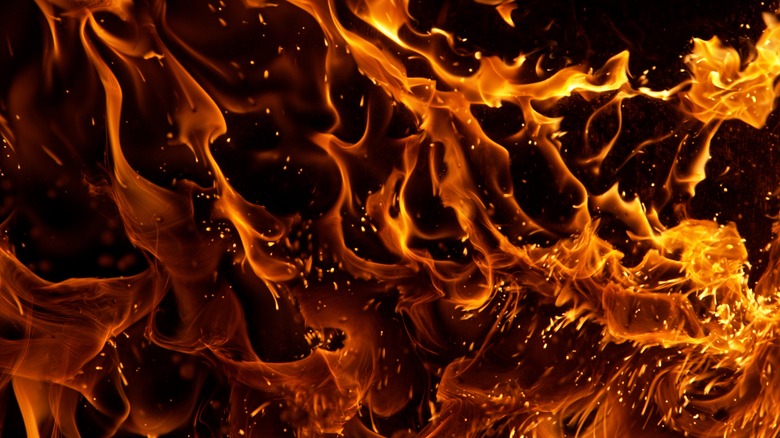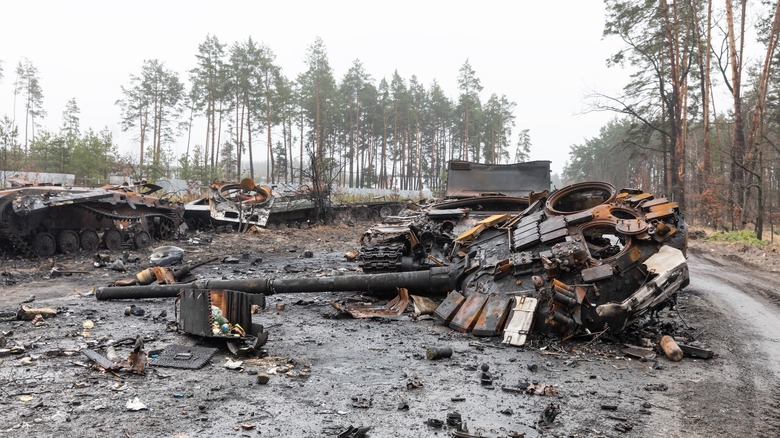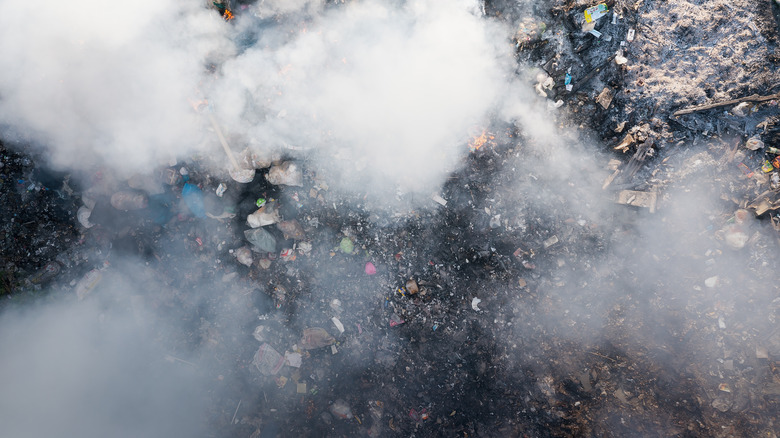What Are Toxic Military Burn Pits?
In the summer of 2022, a rather contentious issue was the source of headlines coming out of Washington for a few weeks. As CNN reports, congressional Democrats were keen to see a bill passed that would, among other things, provide relief for veterans suffering from a specific set of health issues; that is, from the effects of toxic burn pits. For a while, the bill looked like it wasn't going to pass, as Republicans in both chambers stalled its passage. While it looked as if some legislators were holding up the passage of an important bill — in some cases, a literal life-or-death bill (more on that in a moment) — over picayune and procedural reasons, Senate Minority Leader Mitch McConnell noted that stalling bills over amendments and other trivialities is just how it goes in Washington. "Look, these kind of back and forths happen all the time in the legislative process, you've observed that over the years. I think in the end, the veterans service organizations will be pleased with the final result," he said (per CNN).
Lost in the narrative surrounding the bill is the matter of the burn pits themselves, the military waste-disposal process that appears to have put thousands of soldiers at risk, whether they served in Iraq, Afghanistan, or even stateside, according to a companion CNN report.
Disposing Of Military Waste
It's not just consumers and industry that produce waste. The military, whether it's that of the U.S. or literally anywhere else in the word, produces waste. Tons of it. And while much of it likely has to be disposed of according to specific procedures — such as live ordnance, for example — a surprising amount winds up just getting burned in an open pit, according to USA Today. This method of disposing of military waste has been put to particular use in the wars in Iraq and Afghanistan, but they've also been put to use at other overseas military bases, according to Military Times.
Some of the things that have been thrown into them have been mundane: uniforms, pieces of wood, and food, for example. Other things thrown into them shouldn't be burned openly but were disposed of in this way, such as plastics, rubber, petroleum products, and even human and/or medical waste. "Anything and everything that could be burned was thrown in the trash dump and then coated in diesel fuel and lit on fire," said retired Staff Sgt. Wesley Black, via CNN.
These "burn pits" aren't the equivalent of a homeowner disposing of some backyard trash, either. Some of them have been acres in size, according to veterans who spoke to CNN.
The Risks
It should go without saying that disposing of petroleum products, medical waste, and other such detritus is ill-advised, to put it mildly. The smoke from those products can be toxic — and indeed, it has been toxic to an untold number of veterans. Further still, because these pits were/are out in the open, a shift in the wind could put a whole company at risk of exposure. "If you were the poor sucker standing gate guard when that burn pit was lit and the wind was blowing toward the main gate, you'd be standing in the smoke for upwards of eight to 12 hours a day," said Staff Sgt. Wesley Black, via CNN.
According to USA Today, some of the fumes blowing up from burn pits undoubtedly contained carcinogens. Even the non-carcinogenic fumes could cause issues in the eyes, notes, throat, skin, and internal organs. The newspaper also notes that research is ongoing, and some veterans have suggested that exposure to burn pits has led to cancers, respiratory problems, and neurological disorders.
The Risks Aren't Just Theoretical
The risks of exposure to toxic chemicals via military burn pits is not just theoretical: actual men and women are dealing with the consequences of breathing those fumes and particles as you read these words. Retired Staff Sgt. Wesley Black, who served in both Iraq and Afghanistan, told CNN that he has advanced colon cancer, almost certainly caused by exposure to toxic burn pits. "I could be dead tomorrow. I could live another six months ... It really all just depends on how my body responds to the oral chemotherapy, how much more I can squeeze out of the stone," the 35-year-old said. And while retroactively diagnosing a medical condition based on theoretical exposure to a toxin years ago is difficult, Black's oncologist — whom CNN notes was and is not affiliated with the VA hospital system — is almost certain that toxic burn pits are what's going to kill him.
It's unclear just how widespread the problem is and/or will become. One recent survey by Iraq and Afghanistan Veterans of America concluded that 86 percent of the men and women who served in Iraq and/or Afghanistan were potentially exposed to toxic burn pits, and many of them are already reporting symptoms.
How Is This Legal?
You would think that the military would have better systems in place for dealing with its own waste than burning it — consequences be damned. You'd be wrong. Officially, according to Military Times, the Department of Defense claims burn pits should be used only as a last resort. Further still, as of August 2022, they have not been officially banned. Unofficially, "it was still done during deployments if the local combatant commander can't find a suitable alternative," the newspaper notes.
Just how widespread the problem remains is difficult to pin down, but USA Today notes that they're "much less common now. Since 2009, the Pentagon has favored using incinerators when available, which can theoretically contain the smoke and toxins or, at the very least, direct them away from a populated area. Military Times noted that the issue wasn't even a matter of public discussion until January 2021, when Joe Biden mentioned it during his State of the Union Address. In fact, Biden himself may have had a personal connection to the issue (more on this in a moment).
The PACT Act and What It Does
In early August 2022, the Senate passed a bill officially known as the PACT Act — the Sergeant First Class Heath Robinson Honoring our Promise to Address Comprehensive Toxics (PACT) Act, named for a veteran who died of cancer, likely from having been exposed to toxic burn pits (via The White House). Effectively, the act removes the barriers between sickened veterans and getting treatment by, among other things, no longer requiring the individuals to prove that it was the burn pits that caused their health issues. As the White House notes, it's apparent, when all of the data is aggregated, that toxic burn pits are responsible for some veterans' health issues. However, on a case-by-case basis, these claims are hard to prove. The act makes it easier for such veterans to get treatment without having to prove that it was the burn pits that caused their illnesses.
Joe Biden himself may have lost a loved one to toxic burn pits. As Military Times notes, Biden's son, Beau, served in Iraq and later died of brain cancer. It's not known for certain if exposure to burn pits caused his death, but Biden "suspects there was a link," says the newspaper.





